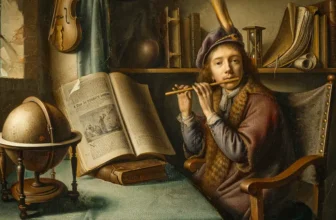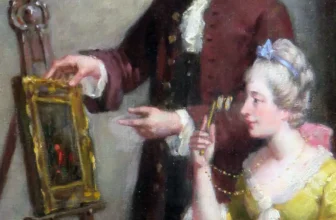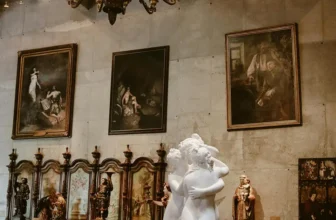Venus and Mars by Botticelli: A Story of Myth, Symbolism, and Renaissance Beauty
Shopping Ads: Antique Oil Paintings On Canvas For Sale. Limited Originals Available 💰😊
Authentic hidden masterpieces, Explore old master antique oil paintings from the Renaissance and Baroque eras. From 15th-century to 18th-century Antique Paintings. Bring the Renaissance and Baroque in your home. Shop Now!
🎨 Antique Oil Paintings On Canvas Renaissance, Baroque Art Antique Oil Paintings, Make Offer 16th to 18th Century Portrait Paintings
In the golden age of the Italian Renaissance, few artists captured the divine grace of classical mythology and the human soul quite like Sandro Botticelli. His works, steeped in allegory, beauty, and idealized love, continue to enchant the modern world centuries after they were first painted. One of his most intriguing and visually poetic masterpieces is the “Venus and Mars”, a painting that brings together the god of war and the goddess of love in a scene that is both serene and suggestive.
But who was Botticelli, and what was he trying to convey through this unique painting? Who are the characters portrayed, and what deeper meanings lie beneath the figures of the slumbering Mars and the watchful Venus?
Let’s delve into the story behind Venus and Mars , a painting that bridges mythology, Renaissance humanism, and timeless themes of love, war, and harmony.
Who is the Artist of Venus and Mars?
The artist behind Venus and Mars is Sandro Botticelli, born Alessandro di Mariano di Vanni Filipepi around 1445 in Florence, Italy. Botticelli was one of the most prominent painters of the Florentine Renaissance, known for his lyrical use of line, graceful figures, and incorporation of classical mythology.
Botticelli trained under Fra Filippo Lippi and later came under the patronage of the powerful Medici family, who were not only political rulers of Florence but also enthusiastic supporters of the arts and humanist philosophy. Botticelli’s most celebrated paintings , such as The Birth of Venus and Primavera , are imbued with Neoplatonic ideas that merge Christian themes with classical pagan motifs.
Venus and Mars, painted around 1485, exemplifies Botticelli’s mature style and thematic interests: mythological storytelling, refined elegance, and a symbolic exploration of human nature.
What Type of Painting is Venus and Mars by Botticelli?
Venus and Mars is an allegorical tempera painting on wood panel, measuring about 69.2 cm by 173.4 cm (27 x 68 inches). It falls under the category of mythological painting, a type that was popular among humanist circles during the Renaissance, particularly in Florence. These works often depicted scenes from ancient Roman and Greek myths not for religious devotion, but for philosophical reflection and decorative pleasure.
The painting is horizontal in orientation , an unusual format for Botticelli , and was likely intended as a decorative panel for a piece of furniture or perhaps to adorn a bedroom, making it a domestic painting rather than one meant for a public or religious setting. This context informs much of its meaning, which ties into love, marriage, and the balance of opposites in a harmonious union.
What Does Venus Symbolize in This Painting?
In Venus and Mars, Venus symbolizes love, reason, and harmony , the civilizing force that tames the chaos of passion and aggression, represented by Mars.
She is shown fully clothed in a luxurious red and white gown, elegant and composed, gazing at the sleeping Mars with a calm and almost knowing expression. Her posture is upright and alert, in contrast to the god of war, who reclines nude and vulnerable in a deep, unguarded slumber.
Venus embodies contemplative love, the kind of divine or Platonic love extolled by Neoplatonist thinkers of the time. Her gaze, powerful and serene, suggests control and mastery over the passions that Mars symbolizes. In essence, she is the force that disarms war, not through violence, but through beauty, desire, and the rational harmony of the soul.
What is the Meaning of the Venus and Mars Painting
At first glance, Venus and Mars is a charming scene from classical mythology: the two gods lounging in a post-coital repose, surrounded by mischievous satyrs. But beneath the surface lies a tapestry of rich and layered meanings.
1. The Harmony of Opposites: Love Tames War
The most widely accepted interpretation is that Botticelli is depicting the harmonious union of opposites , Mars (war, passion, aggression) and Venus (love, reason, beauty). The message is that love conquers war, or more subtly, that when love and desire are governed by reason, peace and harmony follow.
Mars lies disarmed and asleep, his weapons scattered and played with by little fauns, while Venus remains composed and alert. This reversal , the goddess awake and the god asleep , conveys that reason and love are enduring, while aggression and brute strength are transient.
2. Allegory of Marriage and Love
Given the context in which it was likely painted , a piece of art for a newlywed couple’s bedchamber , Venus and Mars can also be read as an allegory for marital harmony.
The painting would remind the viewer that in a good marriage, love should prevail over conflict. Mars, who has succumbed to love and rests peacefully, suggests that sexual satisfaction and emotional intimacy bring peace. Meanwhile, Venus remains ever watchful, suggesting constancy, wisdom, and fidelity.
The satyrs , often symbols of mischief and nature’s raw instincts , playing harmlessly with Mars’ weapons, reinforce the idea that even the most primal forces of conflict are rendered impotent in the face of love’s power.
3. Neoplatonic Interpretation
Renaissance thinkers, especially in Florence, were deeply influenced by Neoplatonism , a philosophical system that attempted to reconcile Platonic thought with Christian ideas.
From a Neoplatonic viewpoint, Venus represents divine love, which leads the soul toward higher truths, while Mars represents earthly passion, which must be subdued and guided. In this sense, the painting becomes more than a love story , it becomes a visual metaphor for the ascension of the soul, with love as the guiding force that brings inner peace.
4. Social and Political Subtext
Some scholars also interpret the painting in a more grounded political context. Florence in the late 15th century was a republic often embroiled in conflicts, both internal and external. The Medici, known for championing peace and the arts, may have commissioned or inspired the theme of the painting as a political allegory , promoting peace (Venus) over war (Mars), a message wrapped in mythological beauty and sensual charm.
Where is Venus and Mars Painting by Botticelli Located Today?
Today, Venus and Mars by Botticelli is part of the prestigious collection of the National Gallery in London, where it has resided since it was acquired in 1874. The painting is housed in Room 58, which features other works of the early Renaissance, offering visitors a chance to see it in the context of Botticelli’s contemporaries.
The National Gallery has done much to preserve and study the painting, contributing significantly to its scholarship and public appreciation. Its vivid colors, delicate details, and ethereal atmosphere continue to draw thousands of visitors each year, fascinated by its elegance and mystery.
Artistic Elements and Visual Analysis
Beyond its symbolic richness, Venus and Mars is a visual feast, filled with artistic subtleties that reflect Botticelli’s unique style:
Composition: The composition is perfectly balanced , Mars reclines on the right, muscular and relaxed, while Venus sits on the left, erect and graceful. The space between them is filled with four small fauns, adding energy and humor to the stillness of the central figures.
Color: Botticelli uses a soft but vibrant color palette , Venus’s red and white gown contrasts with the olive green backdrop, while Mars’s pale flesh tones highlight his vulnerability.
Details: The inclusion of hornets buzzing near Mars’s head, and the wasps on the right edge (believed to be a pun on the Vespucci family name), add layers of personal meaning and clever references.
Textures: Look closely at the luxurious folds of Venus’s dress, the sheen on Mars’s body, the playfulness of the fauns’ fur, and the scattered armor , each element is meticulously rendered, offering a tactile richness.
Legacy and Cultural Impact
Venus and Mars has left an indelible mark on art history. Alongside The Birth of Venus and Primavera, it represents a pinnacle of mythological painting during the Renaissance. Its blend of sensuality, intellect, and poetic ambiguity has inspired generations of artists, writers, and thinkers.
It also serves as a bridge between eras , rooted in classical mythology, expressive of Renaissance humanism, and still relevant in today’s discussions about love, gender dynamics, and the human psyche.
From its playful satyrs to its profound philosophical undercurrents, Botticelli’s painting is a masterclass in layered storytelling through art.
Venus and Mars by Sandro Botticelli is far more than a simple portrayal of mythological lovers. It is a multi-dimensional work of art that uses the language of allegory, beauty, and symbolism to explore profound human themes: the power of love to pacify chaos, the balance of opposites in harmonious union, and the triumph of inner peace over outer conflict.
Whether viewed through the lens of marriage, mythology, politics, or philosophy, the painting invites the viewer into a contemplative space where beauty leads the way. Venus, with her calm demeanor and powerful gaze, reminds us that love , in its highest form , is not just a fleeting emotion, but a force that can transform, transcend, and ultimately bring peace to even the most restless of hearts.
Today, nestled in the walls of the National Gallery in London, Venus and Mars continues its quiet conversation across the centuries, whispering truths as old as time.




